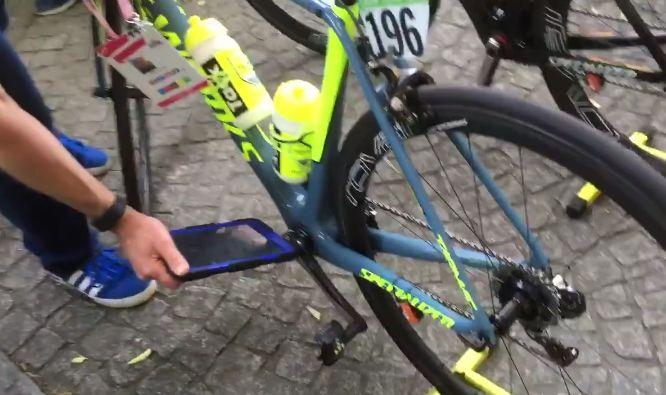- News
- Reviews
- Bikes
- Accessories
- Accessories - misc
- Computer mounts
- Bags
- Bar ends
- Bike bags & cases
- Bottle cages
- Bottles
- Cameras
- Car racks
- Child seats
- Computers
- Glasses
- GPS units
- Helmets
- Lights - front
- Lights - rear
- Lights - sets
- Locks
- Mirrors
- Mudguards
- Racks
- Pumps & CO2 inflators
- Puncture kits
- Reflectives
- Smart watches
- Stands and racks
- Trailers
- Clothing
- Components
- Bar tape & grips
- Bottom brackets
- Brake & gear cables
- Brake & STI levers
- Brake pads & spares
- Brakes
- Cassettes & freewheels
- Chains
- Chainsets & chainrings
- Derailleurs - front
- Derailleurs - rear
- Forks
- Gear levers & shifters
- Groupsets
- Handlebars & extensions
- Headsets
- Hubs
- Inner tubes
- Pedals
- Quick releases & skewers
- Saddles
- Seatposts
- Stems
- Wheels
- Tyres
- Health, fitness and nutrition
- Tools and workshop
- Miscellaneous
- Cross country mountain bikes
- Tubeless valves
- Buyers Guides
- Features
- Forum
- Recommends
- Podcast
news
 UCI checking Tinkoff bike for hidden motor (source Facebook video still).JPG
UCI checking Tinkoff bike for hidden motor (source Facebook video still).JPGMechanical doping: UCI scan for hidden motors at Giro d'Italia (+ video)
UCI officials were scanning bikes for concealed motors today before the start of Stage 11 of the Giro d’Italia in Modena.
The latest checks come a fortnight after the governing body revealed details of the technology it is employing, which use an app paired with a tablet computer to detect electromagnetic waves.
> UCI outlines how it checks for hidden motors
A video posted to Facebook earlier today by Tinkoff shows the scanning taking place on one of the team’s bikes, belonging to rider Pawel Poljanski.
The technology is the same as that used to find a concealed motor in the spare bike of Belgian under-23 rider Femke Van den Driessche at the Cyclo-cross World Championships in January, which resulted in her receiving a six-year ban.
So far, that is the only hidden motor the UCI has discovered – proof, perhaps, that the UCI’s technology is working as a deterrent, or that no-one in the pro peloton was using such a device in the first place.
An investigation by French and Italian media last month concluded that the UCI’s method of scanning for motors was ineffective, however, and that thermal imagining was a better way to catch the cheats.
> Hidden motors used at pro races, claim French and Italian media
The French TV show Stade 2 and Milan-based newspaper Il Corriere della Sera claimed that they had discovered heat signatures from concealed motors on seven bikes at races in Italy during March, including Strade Bianche.
The UCI has maintained, however, that it is confident it is taking the right approach – and added that since Van den Driessche’s bike was a spare and not in use, thermal imaging would not have detected the motor.
It added that it had“also carefully considered and tested alternatives, including thermal imaging, x-ray and ultrasonic testing,” but decided they were “much less effective” than scanning for electromagnetic waves.
“The UCI's trials of the current scanning method showed it is highly effective in detecting hidden motors or any components that could contribute to powered assistance,” it said.
“The scanner creates a magnetic field and the tablet then detects any interruptions to this magnetic field which can come from a motor, magnet or solid object such as a battery concealed in a frame or components.
“The scanners have proved to be a flexible, reliable and highly effective tool which enables large volumes of bikes to be tested in short periods,” it added.
The UCI also said that “It will continue to test heavily in all disciplines throughout the year.”
I think that changed last year. There was a British Cycling National Gravel Championship race held - co-hosted with 1 of the Raiders Gravel days in...
I like that bridge metaphor
Typically you will signs like this one.
However, the highway code revisions now provide more detail and the cyclist overtaking picture has been updated. e.g.:...
And they were right. It says something about our society that people are prepared to put so much money and effort into opposing something as...
Could make a crass joke about how youre only supposed to flip pancakes today, but i wont...
I wouldn't worry too much about the locks being picked, in nearly all cases of bike theft, those Ninja moped gangs, the only things they can pick...
"There's some complex engineering in these things"
They want to pick on The Others in general, rather than a specific group. Immigrants can hate Others just as much as Nigel Farage does.
There's no doubting how bad the sport must have been when a banker feels moral enough to criticise...!